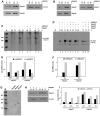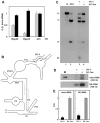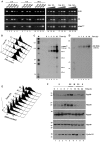Function and assembly of a chromatin-associated RNase P that is required for efficient transcription by RNA polymerase I
- PMID: 19115013
- PMCID: PMC2605565
- DOI: 10.1371/journal.pone.0004072
Function and assembly of a chromatin-associated RNase P that is required for efficient transcription by RNA polymerase I
Abstract
Background: Human RNase P has been initially described as a tRNA processing enzyme, consisting of H1 RNA and at least ten distinct protein subunits. Recent findings, however, indicate that this catalytic ribonucleoprotein is also required for transcription of small noncoding RNA genes by RNA polymerase III (Pol III). Notably, subunits of human RNase P are localized in the nucleolus, thus raising the possibility that this ribonucleoprotein complex is implicated in transcription of rRNA genes by Pol I.
Methodology/principal findings: By using biochemical and reverse genetic means we show here that human RNase P is required for efficient transcription of rDNA by Pol I. Thus, inactivation of RNase P by targeting its protein subunits for destruction by RNA interference or its H1 RNA moiety for specific cleavage causes marked reduction in transcription of rDNA by Pol I. However, RNase P restores Pol I transcription in a defined reconstitution system. Nuclear run on assays reveal that inactivation of RNase P reduces the level of nascent transcription by Pol I, and more considerably that of Pol III. Moreover, RNase P copurifies and associates with components of Pol I and its transcription factors and binds to chromatin of the promoter and coding region of rDNA. Strikingly, RNase P detaches from transcriptionally inactive rDNA in mitosis and reassociates with it at G1 phase through a dynamic and stepwise assembly process that is correlated with renewal of transcription.
Conclusions/significance: Our findings reveal that RNase P activates transcription of rDNA by Pol I through a novel assembly process and that this catalytic ribonucleoprotein determines the transcription output of Pol I and Pol III, two functionally coordinated transcription machineries.
Conflict of interest statement
Figures








Similar articles
-
Human RNase P ribonucleoprotein is required for formation of initiation complexes of RNA polymerase III.Nucleic Acids Res. 2015 Jun 23;43(11):5442-50. doi: 10.1093/nar/gkv447. Epub 2015 May 7. Nucleic Acids Res. 2015. PMID: 25953854 Free PMC article.
-
A role for the catalytic ribonucleoprotein RNase P in RNA polymerase III transcription.Genes Dev. 2006 Jun 15;20(12):1621-35. doi: 10.1101/gad.386706. Genes Dev. 2006. PMID: 16778078 Free PMC article.
-
RNA polymerase I (Pol I) passage through nucleosomes depends on Pol I subunits binding its lobe structure.J Biol Chem. 2020 Apr 10;295(15):4782-4795. doi: 10.1074/jbc.RA119.011827. Epub 2020 Feb 14. J Biol Chem. 2020. PMID: 32060094 Free PMC article.
-
Human RNase P: a tRNA-processing enzyme and transcription factor.Nucleic Acids Res. 2007;35(11):3519-24. doi: 10.1093/nar/gkm071. Epub 2007 May 5. Nucleic Acids Res. 2007. PMID: 17483522 Free PMC article. Review.
-
Survey and summary: transcription by RNA polymerases I and III.Nucleic Acids Res. 2000 Mar 15;28(6):1283-98. doi: 10.1093/nar/28.6.1283. Nucleic Acids Res. 2000. PMID: 10684922 Free PMC article. Review.
Cited by
-
The Diversity of Ribonuclease P: Protein and RNA Catalysts with Analogous Biological Functions.Biomolecules. 2016 May 13;6(2):27. doi: 10.3390/biom6020027. Biomolecules. 2016. PMID: 27187488 Free PMC article. Review.
-
Cancer in Systemic Sclerosis: Analysis of Antibodies Against Components of the Th/To Complex.Arthritis Rheumatol. 2021 Feb;73(2):315-323. doi: 10.1002/art.41493. Epub 2020 Dec 26. Arthritis Rheumatol. 2021. PMID: 33241644 Free PMC article.
-
Human RNase P ribonucleoprotein is required for formation of initiation complexes of RNA polymerase III.Nucleic Acids Res. 2015 Jun 23;43(11):5442-50. doi: 10.1093/nar/gkv447. Epub 2015 May 7. Nucleic Acids Res. 2015. PMID: 25953854 Free PMC article.
-
Human RNase P exhibits and controls distinct ribonucleolytic activities required for ordered maturation of tRNA.Proc Natl Acad Sci U S A. 2023 Oct 17;120(42):e2307185120. doi: 10.1073/pnas.2307185120. Epub 2023 Oct 13. Proc Natl Acad Sci U S A. 2023. PMID: 37831743 Free PMC article.
-
External guide sequence technology: a path to development of novel antimicrobial therapeutics.Ann N Y Acad Sci. 2015 Sep;1354(1):98-110. doi: 10.1111/nyas.12755. Epub 2015 Apr 9. Ann N Y Acad Sci. 2015. PMID: 25866265 Free PMC article. Review.
References
-
- Wassarman KM. RNA regulators of transcription. Nat Struct Mol Biol. 2004;11:803–804. - PubMed
-
- Storz G, Altuvia S, Wassarman KM. An abundance of RNA regulators. Annu Rev Biochem. 2005;74:199–217. - PubMed
-
- Mayer C, Schmitz KM, Li J, Grummt I, Santoro R. Intergenic transcripts regulate the epigenetic state of rRNA genes. Mol Cell. 2006;22:351–361. - PubMed
-
- Kettenberger H, Eisenführ A, Brueckner F, Theis M, Famulok M, et al. Structure of an RNA polymerase II-RNA inhibitor complex elucidates transcription regulation by noncoding RNAs. Nat Struct Mol Biol. 2006;13:44–48. - PubMed
-
- Goodrich JA, Kugel JF. Non-coding-RNA regulators of RNA polymerase II transcription. Nat Rev Mol Cell Biol. 2006;7:612–616. - PubMed
Publication types
MeSH terms
Substances
LinkOut - more resources
Full Text Sources

